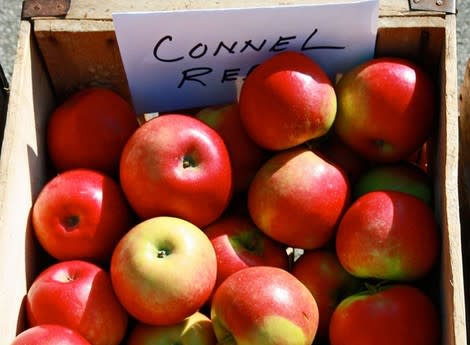How to Taste an Apple like a Pro
Rachel Friedman

The apple may be the simplest of fruits. Just pick it, wash it (or, in a pinch, rub it on your shirt till it shines), and bite in. No peeling or preparation truly necessary. The crunch, sweetness, and tartness that follow are pretty much the definition of instant gratification.
See more: 25 Ways to Use Sriracha
For professional growers, breeders, and scientists, however, eating an apple can be a far more complex process. They're considering texture alongside taste, shelf life in addition to sugar content - not to mention how to make the harvest process easy for local growers.
To get some guidance on how the experts eat apples, we turned to Susan Brown, the Cornell University horticulture professor who last year gave us a preview of RubyFrost and SnapDragon, two new apple breeds that came to market this year. Follow her advice, and you, too, can ace any apple exam.
Refrigerate Your Apples-But Don't Eat Them Cold
Some fruit, including apples, release a gas called ethylene when ripening. Sticking apples in your fridge halts this process. (Commercial storage facilities actually have machines that suck ethylene out of the room.) To keep apples crisp-and texture is a key factor for enjoyment-refrigerate them. "But since aroma also influences flavor," says Brown, "you'll get more of it if you let them warm up to room temperature before taking a bite."
Randomize Your Taste Tests
Cut up 3-5 apple varieties. Try them without knowing the breed. "Now try them again," says Brown. "Do you still like Slice #1 best if it's the first thing you taste?" You might think a sweeter apple tastes even sweeter after trying an acidic one. Consider the mouth feel (when you bite in, is the apple crisp or coarse?) and how much juice is released (some apple cells rupture when you bite them and release juice while others separate from cell to cell and the juice stays within the slice). Instead of limiting your descriptions to sweet, sweet-sour, or balanced, Brown suggests using a wine wheel-with descriptors from "leather" to "lychee" to "cut grass"-for your taste tests.
See more: 7 French Toast Mistakes You're Making
Don't Judge an Apple by Its Skin
Some folks don't like the way yellow apples look, but do like the taste. And when responding to apple tasting surveys, Brown says, "women more commonly found skin thickness an issue than men did." Apple skins aren't an issue at all in Japan, where people peel them off-something Brown doesn't encourage since there are lots of nutrients in the skin and it adds to the complexity of the flavor profile.
Eat Outside the Box
"We tend to like the apples we grow up with, says Brown. Research has also shown that when people have a good experience eating apples, they remember it as even better than it was. When they have a bad experience, they exaggerate its unpleasantness. This is one of Brown's many challenges in finding apples people respond consistently to. Try to broaden your apple-eating palate, and know that kids are likely to eat more of an apple if it's sliced into sections as opposed to offered whole.
The Ripe Way
If you're picking apples from a tree, you should be able to lift at the stem and have it detach easily. If you have to pull, it's not ready. If you're in a store sifting through bicolor apples (like Fujis and McIntoshes), any green sections are where the apple was covered in shade. If that area is dark green, the apple isn't ripe. If it's a lighter shade or yellow, you're looking at a more mature fruit. Another strategy, says Brown, is to "rub your finger over the surface of the apple." If it feels greasy, that baby is past its prime.
SEE MORE FROM BON APPETIT:
10 Snacks You Thought Were Healthy But Really Aren't
Your New Favorite Chocolate Chip Cookie
Classic Old-Fashioned Mixed-Apple Pie

